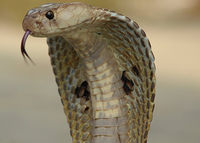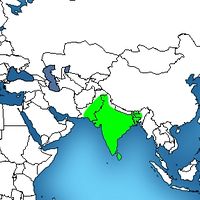Indian cobra
| Indian cobra | ||||||||||||||||||||
|---|---|---|---|---|---|---|---|---|---|---|---|---|---|---|---|---|---|---|---|---|
 Indian cobra
| ||||||||||||||||||||
| Scientific classification | ||||||||||||||||||||
| ||||||||||||||||||||
| Binomial name | ||||||||||||||||||||
| Naja naja (Linnaeus, 1758)[1] | ||||||||||||||||||||
 Distribution of the Indian cobra
| ||||||||||||||||||||
| Synonyms | ||||||||||||||||||||
|
The Indian cobra (Naja naja), also commonly known as the Spectacled cobra, is a species of venomous snake that's native to South Asia (Indian subcontinent). It is a very common snake species throughout all of India, Sri Lanka, Pakistan, Nepal and Bangladesh. This species is a medically important snake as it is responsible for a very large number of snakebites throughout India and every where else it occurs. It has a venom which is primarily neurotoxic and causes respiratory failure if a bite is left untreated. In addition to its neurotoxic component, the venom also contains cytotoxins which cause tissue necrosis. It is one of the "big four" snakes which cause the most snakebites in India.[2] The species is protected in India under the Indian Wildlife Protection Act (1972).
Etymology
The Indian cobra was described by Swedish zoologist Carl Linnaeus in 1758.[3] The generic and specific epithet names naja is a Latinisation of the Sanskrit word nāgá (नाग) meaning "cobra".
Description
This is a medium sized and heavy-bodied snake. The head of this species is elliptical, depressed, very slightly distinct from the neck with a short, rounded snout and large nostrils. The eyes are medium in size with round pupils.[4] This species is typically between 1 m (3.28 ft) and 1.5 m (4.92 ft) in length, but occasionally they may grow to a maximum length of 2.2 m (7.22 ft). The colour and pattern of this species is very variable. The Indian cobra can be grey, yellowish, tan, brown, reddish or black. Some specimens have a dorsal colour pattern and most have a "spectacles" hood mark. The most frequently visible pattern feature is a posteriorly convex light band at the level of the 20th to 25th ventral. This often continues across the ventral side, where it forms the light band between the first and second dark bands. Many specimens, especially adults, also exhibit some salt-and-pepper speckling on the dorsal scales. Some specimens, especially those from Sri Lanka, have a series of often ill-defined, ragged bands along the dorsum. Ontogenetic colour change is common in the northwestern populations, especially those from southern Pakistan and northwestern India. In southern Pakistan, young specimens tend to be grey, with or without a hood mark. Adult specimens are normally uniformly black above, although most of the ventral surface, exluding the throat, remains light. The throat and ventral pattern in this species is also quite variable. In most specimens, there is a light throat area followed by one or several dark bands 4 to 7 ventral scales wide. In adult specimens, there is often a considerable amount of mottling on the throat and on the venter, so that the pattern is much less clear in this species than in some others, such as the Monocled cobra.[5]
Distribution and habitat
Geographical distribution
The Indian cobra is found in Pakistan, where it occurs in parts of the North-West Frontier province and desert areas elsewhere. It is absent in most of Baluchistan. In India it is found throughout the country except for maybe Assam, some areas of Kashmir, elevations above 2000 m (6561.68 ft), and in extreme desert regions. It is also found in Bangladesh, Sri Lanka, and southern Nepal. Mahendra (1984) reports its presense in Bhutan, without further details. The most easterly record comes from the Tangail District, Bangladesh, and the most westerly record is from Duki, Baluchistan. As it has been recorded in Drosh, in the Chitral Valley, it may also occur in the Kabul River Valley in extreme eastern Afghanistan.[2][5]
Habitat
This species is found in a wide range of habitats including plains, jungles, open fields and even heavily populated urban environments, but absent from true desert regions. Favoured locations are holes in embankments, tree hollows, old termite mounds, rock piles and small mammal dens. The Indian cobra is particularly fond of water.[4]
Behaviour and ecology
This species is usually diurnal, tending to search for prey during late afternoon and early evening. They can also be crepuscular in times of very high temperatures.[2] The Indian cobras are non-spitters with a generally mild disposition and generally intent on escape when encountered (juveniles tend to be more aggressive). If cornered and provoked they will spread their hoods, hiss, sway from side to side and strike repeatedly. They are good climbers and swimmers, often observed climbing trees and swimming in streams.[4] They prey mainly on rodents, but also capture other snakes (sometimes their own offspring), lizards and birds. Juveniles feed on mice, insects, lizards, and small frogs. Predators of this species are the mongoose and other snakes, especially the King cobra.[2]
Reproduction
Indian cobras are oviparous and lay their eggs between the months of April and July. The female snake usually lays between 10 to 30 eggs in rat holes or termite mounds and the eggs hatch 48 to 69 days later. The hatchlings measure between 20 and 30 cm (7.9 and 12 in) in length. The hatchlings are independent from birth and have fully functional venom glands.
Venom
The Indian cobra's venom mainly contains a powerful post-synaptic neurotoxin and cardiotoxin.[4][6] The venom acts on the synaptic gaps of the nerves, thereby paralyzing muscles, and in severe bites leading to respiratory failure or cardiac arrest. The venom components include enzymes such as hyaluronidase that cause lysis and increase the spread of the venom. Envenomation symptoms may manifest between 15 minutes to 2 hours following the bite.[7]
In mice, the subcutaneous LD50 range for this species is 0.57 mg/kg[4] - 0.80 mg/kg.[8] The average venom yield per bite is between 169 —250 mg.[4] Though it is responsible for many bites, only a small percentage are fatal if proper medical treatment and anti-venom are given.[9] Mortality rate for untreated bite victims can vary tremendously, but according to one study it is approximately 15-20%.[10] Another study with 1,224 bite cases the mortality rate was only 6.5%.[8]
The Indian cobra is one of the Big four snakes of South Asia (mostly India) which are responsible for the majority of human deaths by snakebite in Asia. Polyvalent serum is available for treating snakebites caused by this species.[11] Zedoary, a local spice with a reputation for being effective against snakebite,[12] has shown promise in experiments testing its activity against cobra venom.
The venom of young cobras has been used as a substance of abuse in India, with cases of snake charmers being paid for providing bites from their snakes. Though this practice is now seen as outdated, symptoms of such abuse include loss of consciousness, euphoria, and sedation.[13]
Cited references
- ↑ Naja naja (TSN 700632) at Integrated Taxonomic Information System. Accessed 10 May 2012.
- ↑ 2.0 2.1 2.2 2.3 Whitaker, Romulus; Captain, Ashok (2004). Snakes of India: The Field Guide. Chennai, India: Draco Books. ISBN 81-901873-0-9.
- ↑ Linnaeus, C. 1758. Systema naturæ per regna tria naturæ, secundum classes, ordines, genera, species, cum characteribus, differentiis, synonymis, locis. Tomus I. Editio decima, reformata. Laurentii Salvii, Holmiæ. 10th Edition: 824 pp.
- ↑ 4.0 4.1 4.2 4.3 4.4 4.5 Indian cobra - General Details at Clinical Toxinology. Accessed 10 May 2012.
- ↑ 5.0 5.1 Wüster, Wolfgang. (1998). The cobras of the genus Naja in India. Hamadryad 23 (1): 15-32
- ↑ Achyuthan, K. E. and L. K. Ramachandran(1981) Cardiotoxin of the Indian cobra (Naja naja) is a pyrophosphatase. J. Biosci. 3(2):149-156 PDF
- ↑ IMMEDIATE FIRST AID for bites by Indian or Common Cobra (Naja naja naja).
- ↑ 8.0 8.1 Brown Ph.D, John H. (1973). Toxicology and Pharmacology of Venoms from Poisonous Snakes. Springfield, IL USA: Charles C. Thomas Publishers, 81. ISBN 0-398-02808-7.
- ↑ Whitaker, Captain, Romulus, Ashok (2004). Snakes of India, The Field Guide. India: Draco Books. ISBN 81-901873-0-9.
- ↑ World Health Organization. "Zoonotic disease control: baseline epidemiological study on snake-bite treatment and management.". Weekly Epidemiological Record (WER) 62 (42): 319–320. ISSN 0049-8114.
- ↑ BBC (Snake-bites: a growing, global threat)
- ↑ Martz W (October 1992). "Plants with a reputation against snakebite". Toxicon 30 (10): 1131–1142. PMID 1440620.
- ↑ [1], Katshu, Mohammad Zia Ul Haq , Dubey, Indu , Khess, C. R. J. and Sarkhel, Sujit (2011) 'Snake Bite as a Novel Form of Substance Abuse: Personality Profiles and Cultural Perspectives', Substance Abuse, 32:1, 43 - 46
External links
- Serpents in Indian culture An article on Biodiversity of India website.